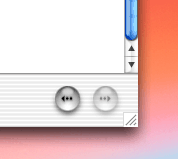she’s got a touch of Tuesday Weld.
Author: Victor
-
IDEA 2002 Winners
Winners of the Industrial Designers Society of America IDEA 2002 Awards (shamelessly ripped out of their frameset. Pfffft). My fav, the BMW Streetcarver skateboard. Ahh, to be a rich youth in Bavaria.
-
Tinderbox Service
Last night, modifying this here blog, I shot Mark Bernstein an email after having tried about ten variations of Tinderbox syntax that I thought should work (I was mistakenly making an assumption instead of paying attention to the docs, prolly some decade old Pascal knowledge rearing its ugly head). This morning in my Inbox was a message from Mark with the corrected syntax. This afternoon, before I had a chance to change my code, was a new version of Tinderbox that made my syntax valid. That’s service!
-
Philip Greenspun’s Future
Philip Greenspun’s Research page reveals several interesting ideas. He’s known for explaining how to build robust database-backed websites when most people were still hand coding everything. That was a process of making everything modular and separated from the presentation, and in many ways the next generation of the web is a continuation of that. He gives the impression of being a mad scientist at times, but the resulting ideas are solid.
-
Silence Between Stations
…A silent 60-second track on the album of his latest classical chart-topping protégés, the Planets, has enraged representatives of the avant-garde, experimentalist composer John Cage, who died in 1992. The silence on his group’s album clearly sounds uncannily like 4’33”, the silence composed by Cage in his prime…. ‘As my mother said when I told her, ‘which part of the silence are they claiming you nicked?‘.’
Thanks Adam.
-
mc.clintock’s Inventory
Did anyone else go right for the medicine cabinet? Kinda disappointing ;-)
-
Learning XHTML
XHTML sounds scary to me. Once you put that X in the name I assume it’s over there, over that threshold of actually learning XML (as opposed to learning what it can do and collaborating with smarter folks who have actually learned it). That’s a pretty common threshold, from what I’ve seen. A lot of us can hack together HTML, maybe CSS or a bit of Javascript, but anything more is for ‘developers’.
Then the other night T. says, ‘Oh, XHTML is the same as HTML 4, you just have to close all your tags.’
Me: like meta tags and BRs, just close them?
T.: Yeah.
Me: [ ! ]Turns out XHTML can be quite simple. Of course, I realize there’s more to it, but ‘just close all your tags‘ might be the line that gets people in the door.
-
The Salon
I’m becoming convinced that the salon is a great model for meeting in person the people to whom you already have an online network connection. A few weeks ago I participated in an IA Salon, and tonight I was invited to another group interested in social network analysis and the like. Both events were attended by fantastically interesting people, most of whom had never met. They were all selected by a central host and took place in a home.
Other events I’ve attended, like groups of bloggers, just don’t have enough in common for conversation to flow naturally. At a salon the connections are more interesting, the atmosphere warmer. Not to mention it’s all easier on the wallet. Recommended.
-
Tall Buildings
There was a fire in the building next to ours. Our elevators don’t work, nor does our air conditioning (and it’s a humid 93 degrees F outside). The connectivity goes in and out, the lights flicker, we smell gas, and the office is on the top floor of a 10-story building. I’m feeling a little vulnerable.
-
Lisa/Macintosh Evolution
Here’s some wonderful sketches of the Macintosh interface evolution that span back to the Lisa prototypes. Those system 6 and 7 screen shots get me all misty-eyed…I used to live and breathe Macintosh in those days. Funny that the Lisa had multitasking and protected memory in 1984, I wonder how that was left out of the Mac? Really, back in 1984, it wasn’t needed in a personal computer. Grafting a user interface onto a free version of Unix probably wouldn’t struck them as pretty damn strange back then.
Thanks to Ben for the link.
-
Comment Survey
Because the Noisy One values your opinion he asks, should Noise Between Stations offer you, my dear visitor, the ability to add comments to each post?
Your answer here.(Survey closed.)Update: The survey revealed 75% in favor. Comments included:
…you might find them annoying after awhile, and after awhile you might find that you are writing more for the audience than yourself…and after awhile you might start to filter your own writing.
Too many cooks spoil the soup. If I wanted to read others’ comments, I’d read their weblogs. Buck the trend and keep NBS comment-less…
Let your thoughts stand in splendid isolation, i’ll link to them then we can all argue over at my place…
Of course! finally!
On occasion I’d like to bat around an idea here, but I don’t want to change the nature of what I originally wanted NBS to be, so I plan on putting in comments sometimes.
It’s funny when I see a high-traffic site link to something interesting on a lower-traffic site, and in so doing ‘stealing’ the community by hosting comments regarding said link. This isn’t my reason for wanting comments here, but it’s worth observing.
-
Moving the Back Button
Using the Help Viewer in Mac OS X I wondered in frustrated amazement that they didn’t include a back button to return to the search results list of documents. In fact, it is there, they just moved it from the top left to the bottom right…

Which is the right place for it. The two most frequently used interface widgets are the scroll bar and the back button. Usually we browse a page and move the scroll bar to the botton right. If we don’t find what we’re looking for it’s the antithesis of efficiency to go to the opposite corner to use the back button. Moving such a commonly used button takes balls on Apple’s part, but it’s a small and important step to improving browser navigation.
While we’re on the subject, the Help Viewer icon cracks me up…

-
A Visual Dictionary
What are zills? Thousands of dollars in musical education didn’t teach me this. When I wanted to know, it just made more sense to look for a picture than for a description.

